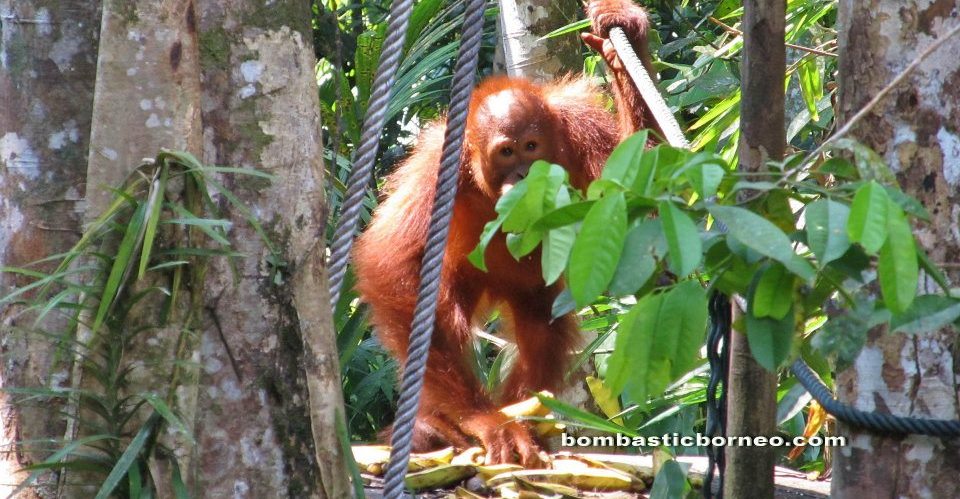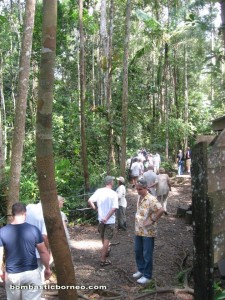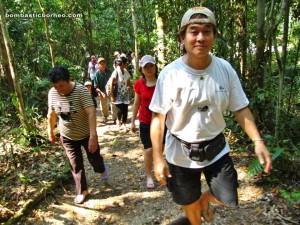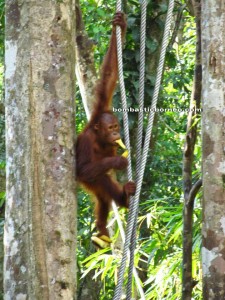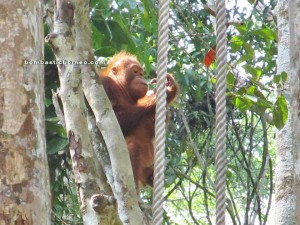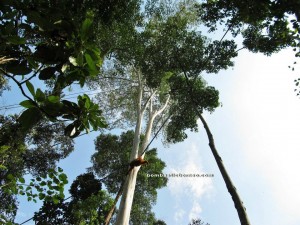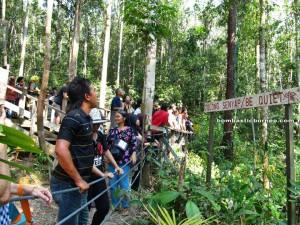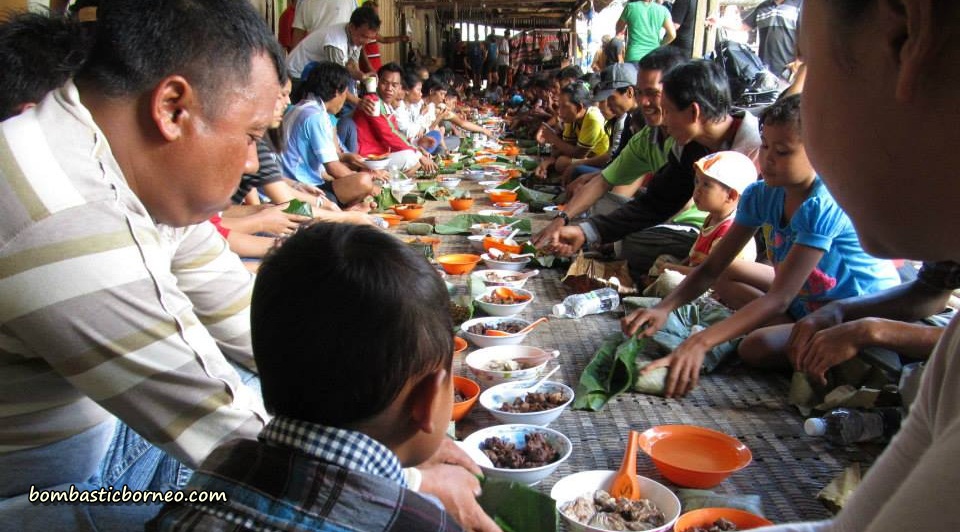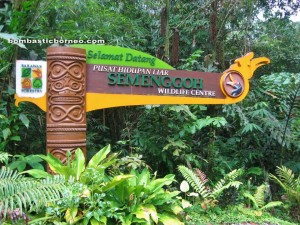 Location : It is located about 24 km south of Kuching and is situated within the boundaries of the Semenggoh Nature Reserve.
Location : It is located about 24 km south of Kuching and is situated within the boundaries of the Semenggoh Nature Reserve.
Open : Monday to Sunday (and public holidays) : 0800 – 1230, 1400 – 1600; Friday : 0800 – 1130, 1400 – 1600
Entrance fee : RM10 for adults and RM3 for children.
Introduction
The Semenggoh Wildlife Centre was established in 1975 to care for wild animals which have either been found injured in the forest, orphaned, or were previously kept as illegal pets.
When established, the three main aims of the Centre were:
- To rehabilitate wild animals who have been injured, orphaned in the wild or handicapped by prolonged captivity, with the objective of subsequently releasing them back to the wild.
- To conduct research on wildlife and captive breeding programs for endangered species.
- To educate visitors and the general public about the importance of conservation.
The Centre has been a resounding success, caring for almost 1,000 endangered mammals, birds and reptiles from dozens of different species. However it is the orang utan rehabilitation program that has made the Centre famous. In one respect, Semenggoh has been too successful – so many orang utan have been successfully reintroduced into the surrounding forest reserve that the forest’s carrying capacity has been reached, and rehabilitation activities have been transferred to the Matang Wildlife Centre, part of Kubah National Park.
As a result of its success, Semenggoh’s role has changed and it is nowadays a centre for the study of orang utan biology and behaviour, as well as a safe and natural haven for dozens of semi-wild orang utan, graduates of the rehabilitation program. It is also home to numerous baby orang utan, born in the wild to rehabilitated mothers, a further testament to the success of the program.
A visit to Semenggoh is a once in a lifetime experience – a chance to see semi-wild orang utan, ranging from tiny infants and boisterous adolescents to dignified mature adults, enjoying life in a secure natural habitat.

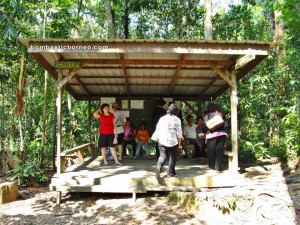
Orang Utan
The orang utan (pongo pygmaeus) is found in the rainforests of Malaysian Borneo (Sarawak and Sabah), Indonesian Borneo (Kalimantan) and North Sumatra. It is one of the world’s largest primates, and is almost completely arboreal (tree living). The word “orang” is Malay for “person” whilst “utan” is derived from “hutan” meaning forest. Thus, orang utan literally translates as “person of the forest”. The name fits well given the primates’ superior intelligence and human-like personalities. The orang utan is an endangered species and is totally protected by law in Malaysia, Indonesia and internationally.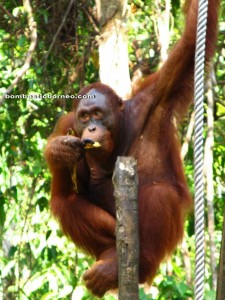
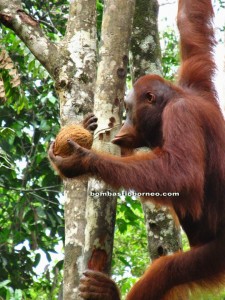

To see more photos, please check out our FACEBOOK PAGE
Feeding Times
Morning : Between 9 a.m. and 10 a.m.
Afternoon : Between 3 p.m. and 3:30 p.m.
As feeding time approaches, the semi-wild orang utan emerge from the rainforest, descending from the forest canopy to the lower branches of trees near feeding platform. But there are no guarantees and possibly only one or two orang utans may show themselves to collect fruit left on platforms.
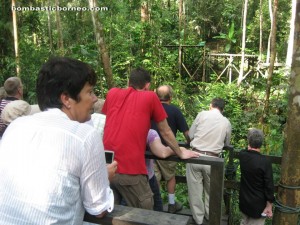
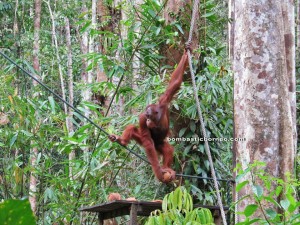
 Rules and Safety When Viewing Orangutans
Rules and Safety When Viewing Orangutans
On occasions, the orang utan may descend from the trees near the Centre HQ and approach visitors. Although this is likely to be an unforgettable experience, visitors should bear in mind that the orang utan, however tame they may appear, are still wild, powerful and potentially dangerous animals. The Centre is also part of a Totally Protected Area. Therefore the following rules & regulations must be observed when visiting the centre.
- Do not hold, feed, touch, play with or in any way disturb the orang utan, and always move at least six metres away from an animal that is on the ground. There are three very good reasons for this. Firstly, the animals may become too attached to humans, making it harder for them to survive in the wild. Secondly humans are able to communicate certain diseases to orang utan, and vice-versa. By eliminating contact the possibility of disease transfer is reduced. Thirdly, an orang utan may feel threatened and attempt to attack you – some of the Semenggoh wardens carry ugly scars from protecting thoughtless visitors from injury.
- Do not bring any food or drinks into the Centre. The orang utan and other animals at the centre already receive a balanced diet, and the smell of food may encourage an animal to approach too closely.
- Do not smoke in the feeding area or any other part of the Forest Reserve.
- Do follow the warden’s instructions and advice at all times.
- Do not collect, or pick plants or animals in Semenggoh Nature Reserve, or in any other Totally Protected Area.
- Do not litter. Please use the litter bins provided.
- Be quite.
- Turn the flash off on your camera!
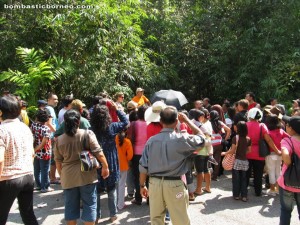
Briefing
Semenggoh’s other attractions
In addition to the orang utan, visitors will be able to see other endangered species at Semenggoh. The centre’s wildlife population varies, so it is difficult to say exactly what animals you may encounter on your visit. However, the centre has housed a wide range of wildlife, including rescued gibbons, porcupines, crocodiles and river terrapins. In the surrounding forest you will certainly hear the cries of rehabilitated gibbons, as well as the songs of a host of wild bird species. Brightly coloured lizards and various species of squirrel are also frequently encountered.
The wildlife rehabilitation centre is part of the Semenggoh Nature Reserve. The other major component of this conversation project is the Botanical Research Centre (BRC). With ethnobotanical gardens, wild fruit orchards, a “Fernarium”, a Rheophyte garden and more, the BRC has much to offer the visitor. Five nature trails and a plankwalk have been laid out to allow visitors the opportunity of seeing the various gardens.
Accommodation
There is no accommodation at Semenggoh and overnight visits are not permitted. Visitors must leave via the main gate by 1645 hrs.
Getting there
From Kuching, take Sarawak Transport Company (Tel : +6082-242967) bus No. 6, (6A, 6B, 6C). Tell the bus driver you wish to be dropped off at the Semenggoh Wildlife Centre and the bus will stop you at the gates. Once you get to the gates, you will be required to purchase an entry permit. From the gate it is a 30 minute walk to the Centre. The last return bus to Kuching is at 1700 hrs. The bus takes approximately 30 minutes to reach Semenggoh.
Visitors can also take a taxi from the main taxi stand in Kuching, or from outside their hotel. Local travel Agents also run guided tours to Semenggoh.
Contacts
National Parks Booking Office
C/O Visitors Information Centre,
Address : Jalan Tun Abang Haji Openg, 93000 Kuching Sarawak.
Tel : (+60)82-248088 Fax: (+60)82-248087
Online booking : http://ebooking.com.my
Sarawak Forestry
Tel : (+60)82-610088 Fax : (+60)82-610099 Toll free line : 1 800 88 2526
Email : info@sarawakforestry.com URL : www.sarawakforestry.com
Semenggoh Wildlife Centre
Tel : (+60)82-618423 Fax : (+60)82-618424
Kuching Visitors’ Information Centre
Located in the Old Courthouse Complex
Tel : (+60)82-410944/410942 Fax : (+60)82-256301
Email : vic-kuching@sarawaktourism.com
Sarawak Tourism Board
Address : 6th & 7th Floor, Bangunan Yayasan Sarawak, Jalan Masjid, 93400 Kuching, Sarawak, Malaysia.
Tel : (+60)82-423600 Fax : (+60)82-416700
Email : stb@sarawaktourism.com URL : www.sarawaktourism.com

